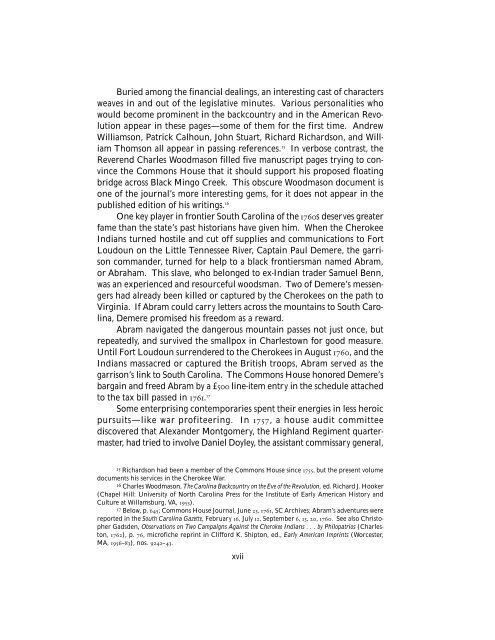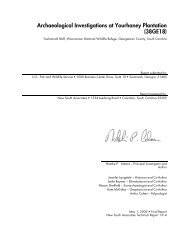<strong>The</strong> legislators handled Fort Loudoun very differently than <strong>the</strong>y hadhandled Fort Prince George just four years earlier. <strong>The</strong>n Governor JamesGlen had persuaded <strong>the</strong>m to forgo examining itemized vouchers; a lumpsum payment <strong>of</strong> £5,000 had settled matters to <strong>the</strong> mutual satisfaction <strong>of</strong> Glenand <strong>the</strong> legislature. 11 Now, in <strong>the</strong> case <strong>of</strong> Fort Loudoun, <strong>the</strong>y read and debatedevery last sum Lyttelton had spent.<strong>The</strong> alleged reason for this thorough audit was that Lyttelton’s commissary—ColonelJohn Chevillette—had incurred “many extraordinarycharges” in connection with <strong>the</strong> fort. 12 But ever since Lyttelton took <strong>of</strong>fice,he had asserted royal prerogative and had attempted to exclude <strong>the</strong> <strong>Commons</strong><strong>House</strong> from knowledge <strong>of</strong> and power over Indian policy. 13 PerhapsLyttelton had <strong>the</strong>reby forfeited some <strong>of</strong> <strong>the</strong> influence his predecessor hadenjoyed. Whatever <strong>the</strong> legislators’ motives, <strong>the</strong>ir meticulous reading <strong>of</strong>Chevillette’s accounts provides a windfall for today’s historians and archeologists,for <strong>the</strong>se accounts give an astonishing amount <strong>of</strong> detailed informationabout Fort Loudoun.Ano<strong>the</strong>r expense that vexed <strong>the</strong> <strong>Commons</strong> <strong>House</strong> was <strong>the</strong> charge <strong>of</strong>carrying provisions to frontier British garrisons. <strong>The</strong> Earl <strong>of</strong> Loudoun had<strong>of</strong>fered to provision <strong>the</strong> Independent Companies if <strong>the</strong> colony would pay<strong>the</strong> transport charges. Eager to be rid <strong>of</strong> <strong>the</strong> two pence sterling additionalpay that South Carolina paid <strong>the</strong> Independents, <strong>the</strong> legislature acceptedLoudoun’s proposal. But afterwards, house members saw a July 1758 articlein London Magazine that seemed to suggest <strong>the</strong> contractors were liable totransport <strong>the</strong> provisions. Thinking that Loudoun and Lyttelton had hoodwinked<strong>the</strong>m, <strong>the</strong>y demanded to see <strong>the</strong> text <strong>of</strong> <strong>the</strong> supply contract.Lyttelton forwarded a copy and pointed out that <strong>the</strong> Crown was responsiblefor <strong>the</strong> carriage, and <strong>the</strong>refore Loudoun’s deal with <strong>the</strong> colonystill stood. <strong>The</strong> legislators fumed that “this Province ought not, by anymeans, to be bur<strong>the</strong>n’d with <strong>the</strong> Expence <strong>of</strong> <strong>the</strong> Carriage <strong>of</strong> Provisions,”but <strong>the</strong>y voted <strong>the</strong> money, anyway, “that His Majesty’s Service may not suffer.” 1411 Terry W. Lipscomb, ed., <strong>The</strong> <strong>Journal</strong> <strong>of</strong> <strong>the</strong> <strong>Commons</strong> <strong>House</strong> <strong>of</strong> <strong>Assembly</strong>, November 21, 1752‒September6, 1754, <strong>The</strong> Colonial Records <strong>of</strong> South Carolina (Columbia: University <strong>of</strong> South Carolina Press for<strong>the</strong> South Carolina Department <strong>of</strong> Archives and History, 1983), pp. 474, 527, 528, 531.12 Below, p. 67. Considering <strong>the</strong> reluctance <strong>the</strong> house had shown to build Fort Loudoun at all,<strong>the</strong>ir attitude is not surprising. <strong>The</strong> legislators believed that this fort was <strong>of</strong> peripheral interest toSouth Carolina and that <strong>the</strong> Crown should have financed it. Moreover, Chevillette’s accounts seem tohave exceeded <strong>the</strong> fixed amount that <strong>the</strong> house had voted for <strong>the</strong> fort in 1756. See Terry W. Lipscomb,ed., <strong>The</strong> <strong>Journal</strong> <strong>of</strong> <strong>the</strong> <strong>Commons</strong> <strong>House</strong> <strong>of</strong> <strong>Assembly</strong>, November 20, 1755–July 6, 1757, <strong>The</strong> Colonial Records <strong>of</strong>South Carolina (Columbia: University <strong>of</strong> South Carolina Press for <strong>the</strong> South Carolina Department <strong>of</strong>Archives and History, 1986), pp. XXVii‒XXViii, 480, 486–87.13 Jack P. Greene, <strong>The</strong> Quest For Power: <strong>The</strong> Lower <strong>House</strong>s <strong>of</strong> <strong>Assembly</strong> in <strong>the</strong> Sou<strong>the</strong>rn Royal Colonies,1689–1776 (Chapel Hill: University <strong>of</strong> North Carolina Press, 1963), pp. 321–23.14 Below, pp. 56–57, 177, 344, 348, 426–27.xvi
Buried among <strong>the</strong> financial dealings, an interesting cast <strong>of</strong> charactersweaves in and out <strong>of</strong> <strong>the</strong> legislative minutes. Various personalities whowould become prominent in <strong>the</strong> backcountry and in <strong>the</strong> American Revolutionappear in <strong>the</strong>se pages—some <strong>of</strong> <strong>the</strong>m for <strong>the</strong> first time. AndrewWilliamson, Patrick Calhoun, John Stuart, Richard Richardson, and WilliamThomson all appear in passing references. 15 In verbose contrast, <strong>the</strong>Reverend Charles Woodmason filled five manuscript pages trying to convince<strong>the</strong> <strong>Commons</strong> <strong>House</strong> that it should support his proposed floatingbridge across Black Mingo Creek. This obscure Woodmason document isone <strong>of</strong> <strong>the</strong> journal’s more interesting gems, for it does not appear in <strong>the</strong>published edition <strong>of</strong> his writings. 16One key player in frontier South Carolina <strong>of</strong> <strong>the</strong> 1760s deserves greaterfame than <strong>the</strong> state’s past historians have given him. When <strong>the</strong> CherokeeIndians turned hostile and cut <strong>of</strong>f supplies and communications to FortLoudoun on <strong>the</strong> Little Tennessee River, Captain Paul Demere, <strong>the</strong> garrisoncommander, turned for help to a black frontiersman named Abram,or Abraham. This slave, who belonged to ex-Indian trader Samuel Benn,was an experienced and resourceful woodsman. Two <strong>of</strong> Demere’s messengershad already been killed or captured by <strong>the</strong> Cherokees on <strong>the</strong> path toVirginia. If Abram could carry letters across <strong>the</strong> mountains to South Carolina,Demere promised his freedom as a reward.Abram navigated <strong>the</strong> dangerous mountain passes not just once, butrepeatedly, and survived <strong>the</strong> smallpox in Charlestown for good measure.Until Fort Loudoun surrendered to <strong>the</strong> Cherokees in August 1760, and <strong>the</strong>Indians massacred or captured <strong>the</strong> British troops, Abram served as <strong>the</strong>garrison’s link to South Carolina. <strong>The</strong> <strong>Commons</strong> <strong>House</strong> honored Demere’sbargain and freed Abram by a £500 line-item entry in <strong>the</strong> schedule attachedto <strong>the</strong> tax bill passed in 1761. 17Some enterprising contemporaries spent <strong>the</strong>ir energies in less heroicpursuits—like war pr<strong>of</strong>iteering. In 1757, a house audit committeediscovered that Alexander Montgomery, <strong>the</strong> Highland Regiment quartermaster,had tried to involve Daniel Doyley, <strong>the</strong> assistant commissary general,15 Richardson had been a member <strong>of</strong> <strong>the</strong> <strong>Commons</strong> <strong>House</strong> since 1755, but <strong>the</strong> present volumedocuments his services in <strong>the</strong> Cherokee War.16 Charles Woodmason, <strong>The</strong> Carolina Backcountry on <strong>the</strong> Eve <strong>of</strong> <strong>the</strong> Revolution, ed. Richard J. Hooker(Chapel Hill: University <strong>of</strong> North Carolina Press for <strong>the</strong> Institute <strong>of</strong> Early American History andCulture at Willamsburg, VA, 1953).17 Below, p. 645; <strong>Commons</strong> <strong>House</strong> <strong>Journal</strong>, June 23, 1761, SC Archives; Abram’s adventures werereported in <strong>the</strong> South Carolina Gazette, February 16, July 12, September 6, 13, 20, 1760. See also ChristopherGadsden, Observations on Two Campaigns Against <strong>the</strong> Cherokee Indians . . . by Philopatrios (Charleston,1762), p. 76, micr<strong>of</strong>iche reprint in Clifford K. Shipton, ed., Early American Imprints (Worcester,MA, 1956–83), nos. 9242–43.xvii







